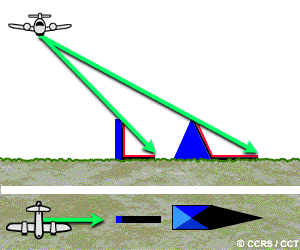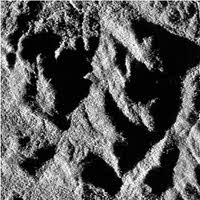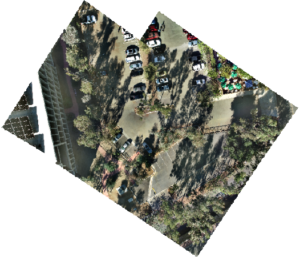The side looking property of radar systems, surface slopes and other terrain features causes geometric and radiometric distortion in image data acquired by SAR systems. The geometric distortion are foreshortening and layover. The radiometric distortion results in shadow.
If a radar sensor is unable to see the other side of a feature, there will be shadow in the resulting image. This usually occur over vertical or steep slope features as the radar beam illuminates one side of the feature while the beam does not get to the other side resulting in black pixels over this region( since there is no energy to backscatter). The image below illustrates radar shadow effects on the right side of the hillsides which are being illuminated from the left. A good way to minimize shadow is to reduce the look angle. As can be seen from the geometry, there will be no shadow if the radar is looking straight down. However, there will be ambiguity in range.


A sample radar image with shadow effect is shown below.




Foreshortening is illustrated using the image below. Foreshortening occurs when the radar pulses gets to the bottom (point a) of a tall feature inclined towards the sensor before it reaches the top (point b). This result in shortening of the actual length of the sensor-facing slopes as shown by length a’b’.
Layover occurs when the radar beam reaches and images the top of a tall feature before the base. The return signal from the top of the feature will be received before the signal from the bottom. As a result, the top of the feature is displaced towards the radar from its true position on the ground, and “lays over” the base of the feature (b’ to a’).
Both foreshortening and layover can be reduced if the look angle is increased. However, large look angle produces more image shadow. Hence, these topography-related image distortions can not be entirely removed.
Besides the geometric and radiometric distortions caused by terrain discussed above, SAR images are additionally characterized by somewhat grainy appearances resembling “salt and pepper” that is commonly referred to as speckle. The speckle is a result of interference from the many scattering echoes within a resolution cell. Speckle noise is distinguished from most other noise by its dependence on image brightness. However, it is difficult to treat as the true radar brightness σ of an image needs to be known to optimally filter the image.


